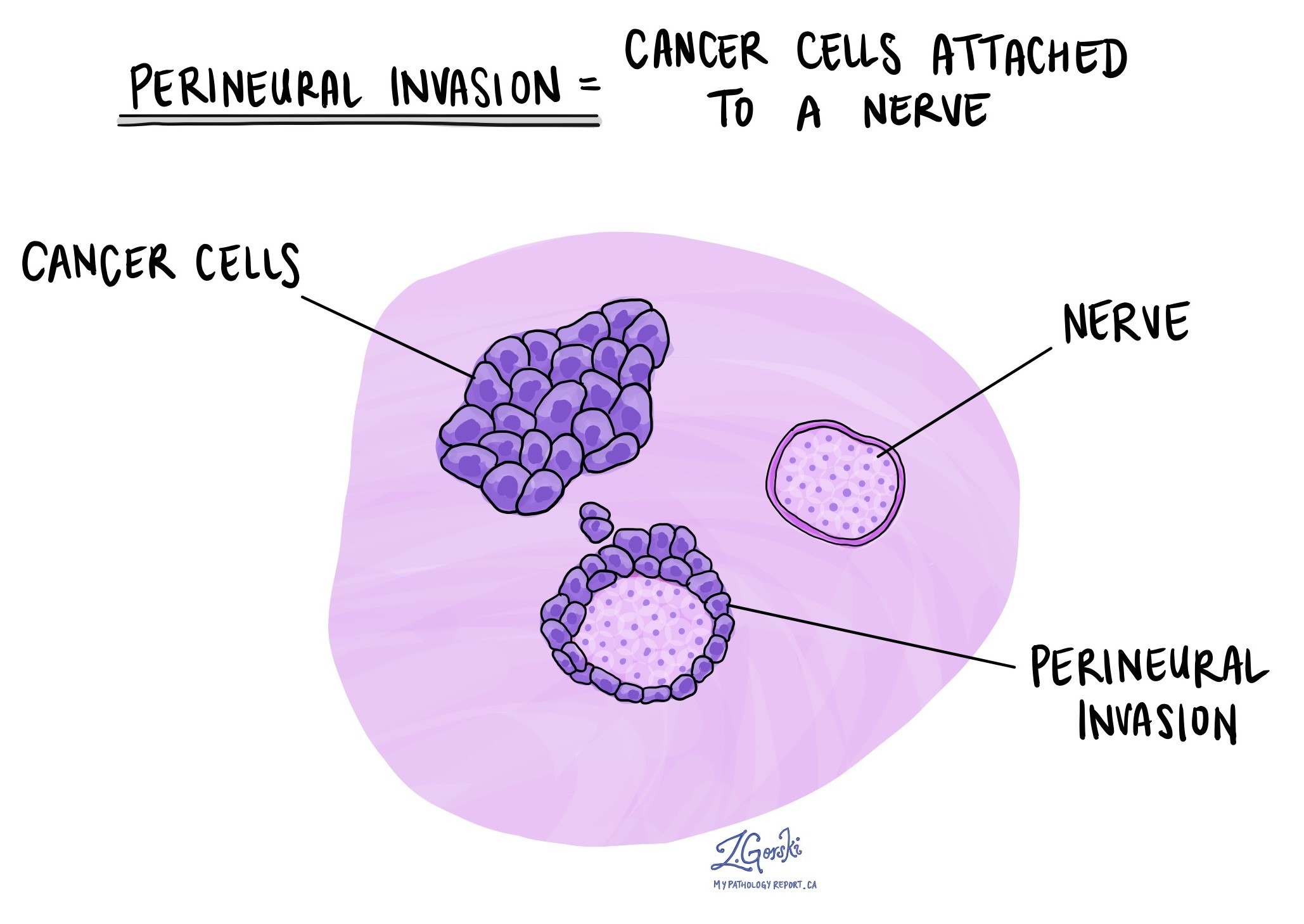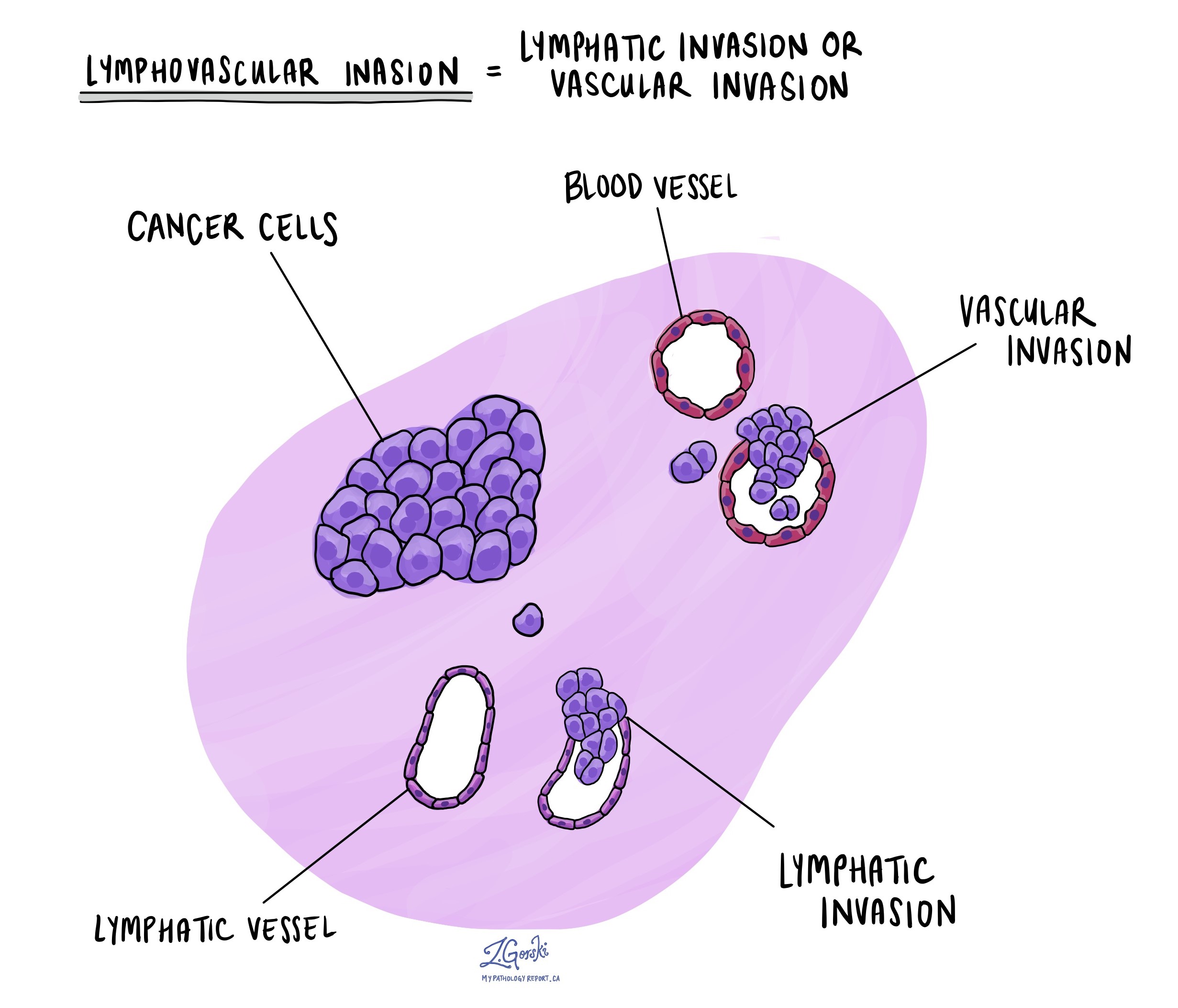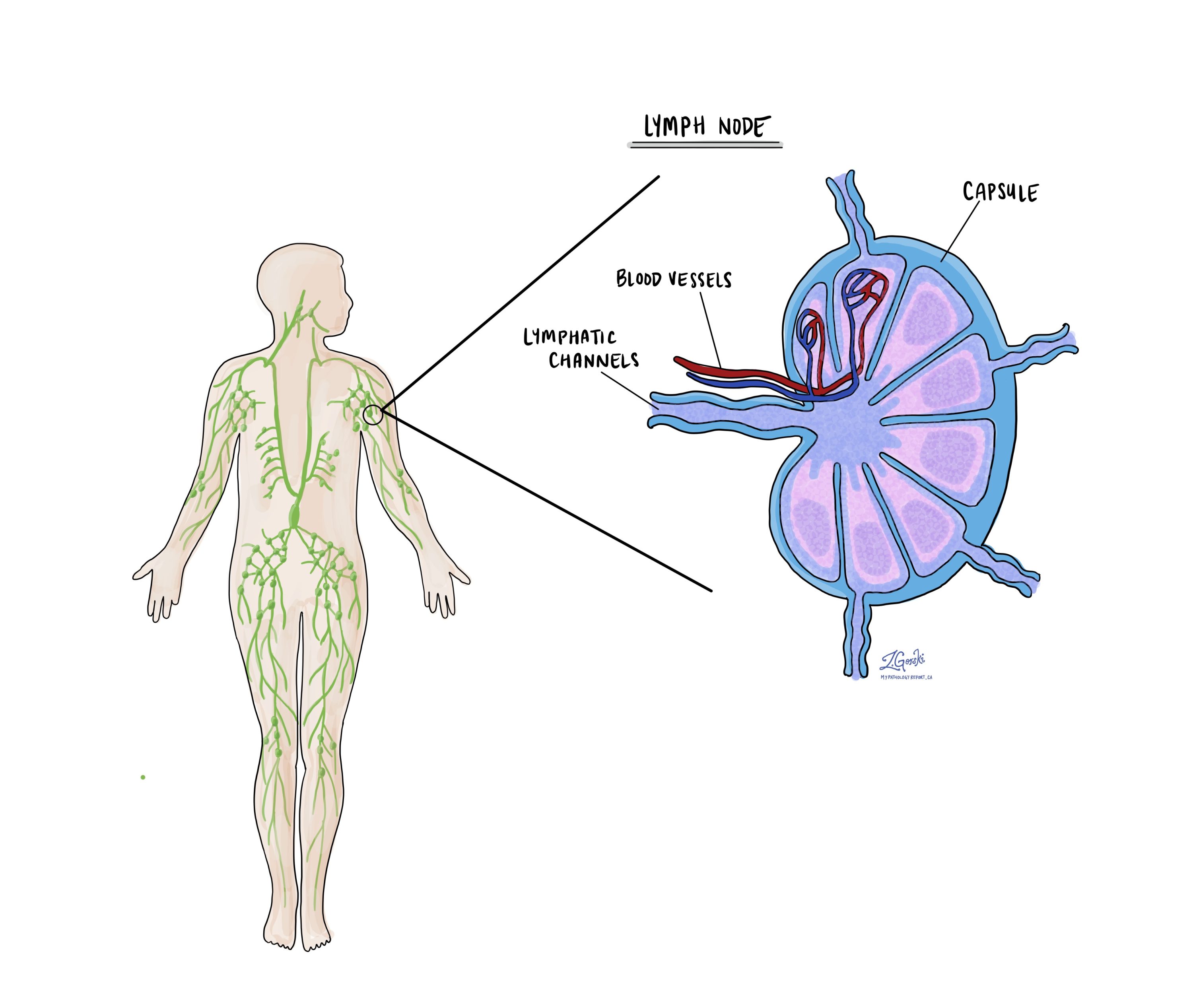by Jason Wasserman MD PhD FRCPC and Bibianna Purgina MD FRCPC
July 25, 2024
Background:
Epithelioid sarcoma is a type of soft tissue cancer. It is called epithelioid because the tumour cells look and behave like epithelial cells that are normally found on the outside or inside surface of any organ. Although epithelioid sarcoma can occur almost anywhere in the body, the most common location is the hand.
What causes epithelioid sarcoma?
The exact cause of epithelioid sarcoma is not well understood. Like many cancers, it’s thought to result from genetic changes in the body’s cells that lead to uncontrolled growth. However, it’s important to note that these changes are usually not inherited but occur randomly.
What are the symptoms of epithelioid sarcoma?
The symptoms of epithelioid sarcoma typically include a painless, slow-growing mass just under the skin. Over time, an ulcer may develop in the overlying skin. Tumours in deep locations may not cause any symptoms until they are very large or the cells have spread to nearby lymph nodes.
How is this diagnosis made?
Diagnosing epithelioid sarcoma typically involves a combination of medical imaging and a biopsy. Imaging tests like MRI or CT scans can detect the presence of a mass and its size and location. A biopsy, where a small tumour sample is removed and examined under a microscope, is crucial for confirming the diagnosis.
Subtypes of epithelioid sarcoma
There are two subtypes of epithelioid sarcoma: classic or distal type and proximal or large cell type. The classic (distal) subtype usually involves the hands or feet, while the proximal (large cell) subtype involves the deep tissue of the chest, abdomen, or pelvis.
Microscopic features of this tumour
Classic subtype epithelioid sarcoma
Classic (distal) type epithelioid sarcoma comprises epithelioid and spindle cells arranged in groups called nodules. A type of cell death called necrosis is often seen in the centre of the nodule. The nodules of tumour cells can be mistaken for a necrotizing granuloma, a type of inflammation seen in infections. The cytoplasm (body) of the tumour cells is filled with eosinophilic material, which gives the cells a pink look under the microscope.
Proximal (large cell) subtype epithelioid sarcoma
Proximal (large cell) epithelioid sarcoma is also made up of epithelioid and spindle cells arranged in multiple nodules or large groups called sheets. In contrast to the classic type, the proximal type is less likely to be confused for a necrotizing granuloma.

Additional tests
Pathologists typically perform a test called immunohistochemistry (IHC) to confirm the diagnosis and to rule out other conditions that can look very similar to epithelioid sarcoma under the microscope. When immunohistochemistry is performed, the tumour cells are typically positive for epithelial markers, including low- and high-molecular-weight cytokeratins, cytokeratin 8/18, and cytokeratin 9/19. Unlike real epithelial cells, the tumour cells in epithelioid sarcoma are also positive for CD34. Importantly, the tumour cells in epithelioid sarcoma show a loss of normal SMARCB1 (also known as INI1) protein expression and this loss allows the tumour cells to grow and divide in an uncontrolled manner.
Tumour grade
Pathologists use the French Federation of Cancer Centers Sarcoma Group (FNCLCC) grading system to assign a grade to most types of soft tissue cancers. However, this system is not commonly applied to epithelioid sarcomas because all epithelioid sarcomas are considered high grade tumours that behave aggressively over time.
Treatment effect
If you received chemotherapy and/or radiation therapy before the operation to remove the tumour, your pathologist will examine all the tissue sent to pathology to see how much of the tumour was still alive at the time it was removed from the body. Pathologists use the term viable to describe tissue that was still alive when it was removed from the body. In contrast, pathologists use the term non-viable to describe tissue that was not alive when it was removed from the body. Most commonly, your pathologist will describe the percentage of tumours that is non-viable.
Perineural invasion
Pathologists use the term “perineural invasion” to describe a situation where cancer cells attach to or invade a nerve. “Intraneural invasion” is a related term that specifically refers to cancer cells found inside a nerve. Nerves, resembling long wires, consist of groups of cells known as neurons. These nerves, present throughout the body, transmit information such as temperature, pressure, and pain between the body and the brain. The presence of perineural invasion is important because it allows cancer cells to travel along the nerve into nearby organs and tissues, raising the risk of the tumour recurring after surgery.

Lymphovascular invasion
Lymphovascular invasion occurs when cancer cells invade a blood vessel or lymphatic channel. Blood vessels, thin tubes that carry blood throughout the body, contrast with lymphatic channels, which carry a fluid called lymph instead of blood. These lymphatic channels connect to small immune organs known as lymph nodes scattered throughout the body. Lymphovascular invasion is important because it enables cancer cells to spread to other body parts, including lymph nodes or the lungs, via the blood or lymphatic vessels.

Margins
In pathology, a margin is the edge of tissue removed during tumour surgery. The margin status in a pathology report is important as it indicates whether the entire tumour was removed or if some was left behind. This information helps determine the need for further treatment.
Pathologists typically assess margins following a surgical procedure, like an excision or resection, aimed at removing the entire tumour. Margins aren’t usually evaluated after a biopsy, which removes only part of the tumour. The number of margins reported and their size—how much normal tissue is between the tumour and the cut edge—vary based on the tissue type and tumour location.
Pathologists examine margins to check if tumour cells are present at the tissue’s cut edge. A positive margin, where tumour cells are found, suggests that some cancer may remain in the body. In contrast, a negative margin, with no tumour cells at the edge, suggests the tumour was fully removed. Some reports also measure the distance between the nearest tumour cells and the margin, even if all margins are negative.

Lymph nodes
Lymph nodes are small immune organs found throughout the body. Cancer cells can spread from a tumour to lymph nodes through small lymphatic vessels. For this reason, lymph nodes are commonly removed and examined under a microscope to look for cancer cells. The movement of cancer cells from the tumour to another part of the body, such as a lymph node, is called a metastasis.

Cancer cells typically spread first to lymph nodes close to the tumour, although lymph nodes far away from the tumour can also be involved. For this reason, the first lymph nodes removed are usually close to the tumour. Lymph nodes further away from the tumour are only typically removed if they are enlarged and there is a high clinical suspicion that there may be cancer cells in the lymph node.
If any lymph nodes were removed from your body, they will be examined under the microscope by a pathologist, and the results of this examination will be described in your report. The examination of lymph nodes is important for two reasons. First, this information determines the pathologic nodal stage (pN). Second, finding cancer cells in a lymph node increases the risk that cancer cells will be found in other parts of the body in the future. As a result, your doctor will use this information when deciding if additional treatment, such as chemotherapy, radiation therapy, or immunotherapy, is required.
Some helpful definitions:
- Positive: Positive means that cancer cells were found in the lymph node being examined.
- Negative: Negative means that no cancer cells were found in the lymph node being examined.
- Deposit: The term deposit describes a group of cancer cells inside a lymph node. Some reports include the size of the largest deposit. A similar term is “focus”.
- Extranodal extension: Extranodal extension means that the tumour cells have broken through the capsule on the outside of the lymph node and have spread into the surrounding tissue.

Pathologic stage (pTNM)
The pathologic stage for epithelioid sarcoma is based on the TNM staging system, an internationally recognized system created by the American Joint Committee on Cancer. This system uses information about the primary tumour (T), lymph nodes (N), and distant metastatic disease (M) to determine the complete pathologic stage (pTNM). Your pathologist will examine the tissue submitted and give each part a number. In general, a higher number means a more advanced disease and a worse prognosis.
Tumour stage (pT)
The tumour stage for epithelioid sarcoma is based on the tumour size and the tumour extension into surrounding tissues. The staging system used also varies based on the body part involved. For example, a 5-centimetre tumour that starts in the head will be given a different tumour stage than a tumour that starts deep in the back of the abdomen (the retroperitoneum). However, in most body sites, the tumour stage includes the tumour size and whether the tumour has grown into surrounding body parts.
Head and neck
- T1 – The tumour is no greater than 2 centimetres in size.
- T2 – The tumour is between 2 and 4 centimetres in size.
- T3 – The tumour is greater than 4 centimetres in size.
- T4 – The tumour has grown into surrounding tissues such as the bones of the face or skull, the eye, the larger blood vessels in the neck, or the brain.
Chest, back, or stomach and the arms or legs (trunk and extremities)
- T1 – The tumour is no greater than 5 centimetres in size.
- T2 – The tumour is between 5 and 10 centimetres in size.
- T3 – The tumour is between 10 and 15 centimetres in size.
- T4 – The tumour is greater than 15 centimetres in size.
Abdomen and organs inside the chest (thoracic visceral organs)
- T1 – The tumour is only seen in one organ.
- T2 – The tumour has grown into the connective tissue surrounding the organ from which it started.
- T3 – The tumour has grown into at least one other organ.
- T4 – Multiple tumours are found.
Retroperitoneum (the space at the very back of the abdominal cavity)
- T1 – The tumour is no greater than 5 centimetres in size.
- T2 – The tumour is between 5 and 10 centimetres in size.
- T3 – The tumour is between 10 and 15 centimetres in size.
- T4 – The tumour is greater than 15 centimetres in size.
Tissue around the eye (orbit)
- T1 – The tumour is no greater than 2 centimetres in size.
- T2 – The tumour is greater than 2 centimetres in size but has not grown into the bones surrounding the eye.
- T3 – The tumour has grown into the bones surrounding the eye or other bones of the skull.
- T4 – The tumour has grown into the eye (the globe) or the surrounding tissues such as the eyelids, sinuses, or brain.
Nodal stage (pN)
Epithelioid sarcoma is given a nodal stage of 0 or 1 based on the presence or absence of tumour cells in one or more lymph nodes. If no tumour cells are seen in any lymph nodes, the nodal stage is N0. If no lymph nodes are sent for pathological examination, the nodal stage cannot be determined, and the nodal stage is listed as NX. If tumour cells are found in any lymph nodes, then the nodal stage is listed as N1.
About this article
Doctors wrote this article to help you read and understand your pathology report. If you have additional questions, contact us.

